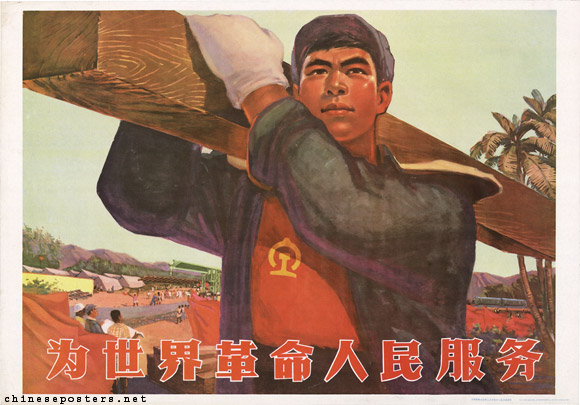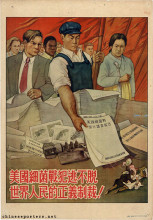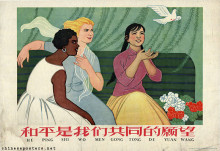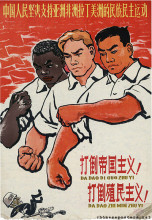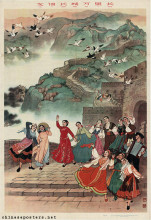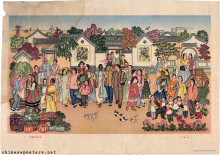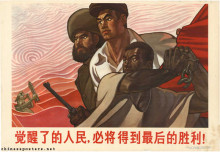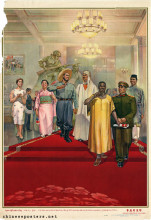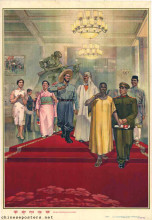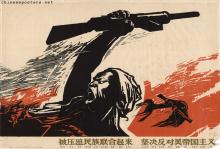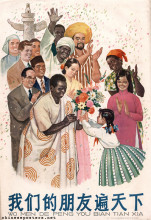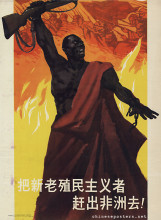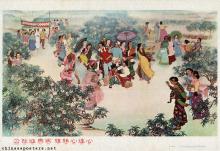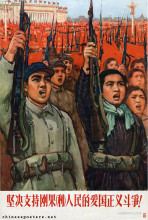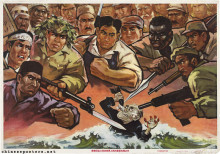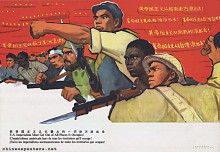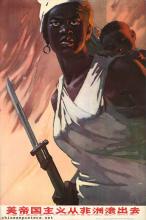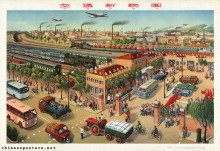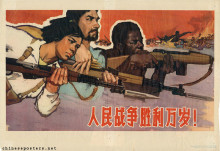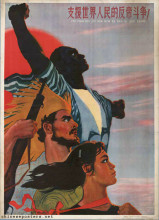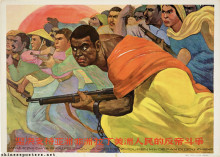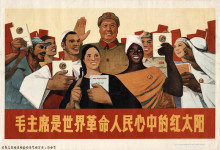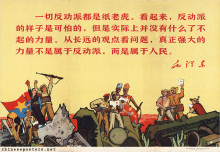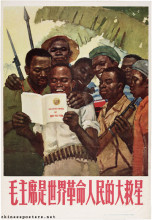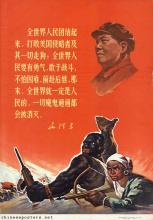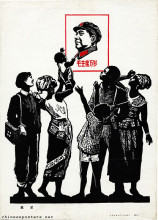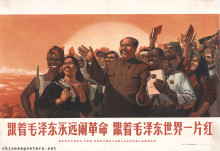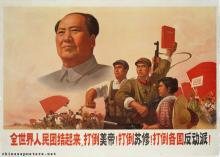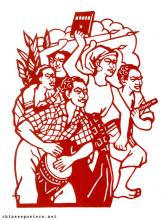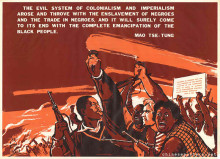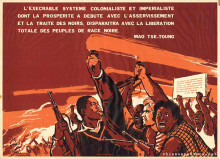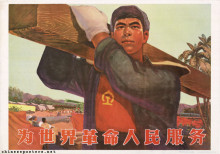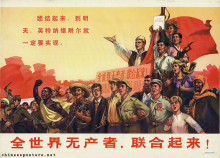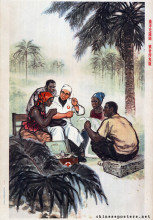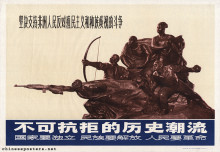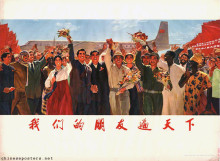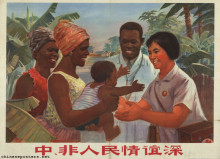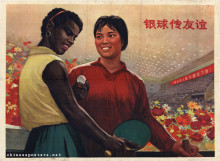Serve the revolutionary people of the world, 1971
The TAZARA railway (Tanzan Tielu 坦赞铁路) was designed and constructed between 1968 and 1976. The 1,860 km long project was built with financial and technical assistance from China, amounting to well over US$400 mn, in the form of a long-term interest-free loan. Known as the "Freedom Railway" or the Great Uhuru Railway, TAZARA was conceived to provide the critical outlet to the sea that landlocked Zambia needed in order to break free from its dependency on Rhodesian (Zimbabwean), Angolan and South African rails and ports. TAZARA was therefore a transnational as well as a Pan-African project, intended to serve as a symbol of revolutionary Third World solidarity and resistance to the forces of colonialism, neocolonialism and imperialism. The Chinese participation in this and other projects, which also included sending technical experts and doctors to Africa and granting Africans with scholarships for study in China, had less to do at the time with economic considerations than with political ones: it formed an obvious part of Beijing’s ideological strategy to counter the influence of the Soviet Union in (East) Africa. Moreover, the support of African countries was sought and needed to bolster Beijing’s attempts to reclaim its seat in the United Nations.
A link between Zambia and Tanzania had originally been envisaged by Cecil Rhodes but this imperial dream was never realized. Between 1963 and 1966, a number of feasibility studies for the construction of the line were conducted and requests for finance were submitted to Britain, the United States, Canada, West Germany, France, the Soviet Union, the World Bank, and the African Development Bank. But no firm offers were received from any of these and the Tanzanian and Zambian Governments therefore turned to China. After numerous discussions, a Chinese team arrived in August 1965 to briefly study conditions of the Tanzanian section of the proposed project. In September 1967, a tripartite agreement was signed in Peking under which China undertook to make a full survey of the line and formally committed itself to build and finance the railway. Further negotiations between the three countries in April 1968 (Dar es Salaam) and November 1969 (Lusaka) led to the signing of the final agreement in July 1970 (Peking).
The cost of the railway was estimated at US$400 million and if the actual costs were higher than estimate, the extra sum would be given by China as a grant. The US$400 million was provided in the form of an interest-free loan, since the Chinese never charged interest on any of the aid they provided. The loan would be repayable over thirty years, after a grace period of a decade, which meant that repayments would be due between the years 1983 and 2012. During the 1980s, a number of multi-national agreements, this time including Western donors as well, saw to it that the operational costs of the railway, acquisition of rolling stock and other expenses were met.
Construction of the railway began in April 1970 and work proceeded ahead of schedule with the track crossing into Zambia in August 1973. In terms of engineering, the construction was no small feat, particularly on the Tanzanian section, where the track rises from sea level to almost 6,000 feet. All in all, 22 tunnels and 300 bridges needed to be built in Tanzania alone. Up to 15,000 Chinese and 45,000 African workers were engaged on the project during the peak period. The railway was completed in 1975 and operations began in July 1976.
The friendship road - the TANZAN Railway, 1976
Following the formal transfer of the railway in 1976, some 1,000 Chinese experts originating from 36 different railway "work units" (danwei) throughout China, stayed on in either Tanzania or Zambia as Chinese Railway Experts to continue the task of technology transfer in the operations period. These Experts Teams operated under the immediate leadership of the Chinese Embassy and its Economic and Commercial Representative in Tanzania. In China they were directly affiliated with the Department of Foreign Aid of the Ministry of Railways; after 2003, they were administered by the China Civil Engineering Construction Company (CCECC) under the authority of the Ministry of Foreign Trade and Economic Cooperation (MOFTEC) and the Ministry of Commerce.
At present, TAZARA is still in operation, having survived falling revenues, maintenance backlogs, worker discontent over reductions and pension plans, etc. Its operating costs have been secured with a new infusion of Chinese financial aid (US$40 million in December 2010), leading to the projection that the operation will turn a profit in 2011, for the first time since the railway was taken into operation.
Although TAZARA is still seen as China’s most ambitious project in Africa, its functions have evolved from an ideo-political one into an economic one, emphasizing resource acquisition. In the process, the Chinese involvement has shifted from active participation in surveying and construction, to undertaking joint-management with the African partners, to providing management advice and technical guidance. As such, it very much reflects the past three decades’ developments and changes in China itself. On both ends of the railway, China has developed, or is in the process of developing, Special Economic Zones that will facilitate its further economic growth. Now that China is increasingly interested in economic cooperation with African nations, TAZARA serves as a powerful symbol of Beijing’s early and continuing commitment to and support for African nations.
Martin Bailey, "Tanzania and China", African Affairs 74/249 (1975)
Martin Bailey, "Chinese Aid in Action: Building the Tanzania-Zambia Railway". World Development 3:7-8 (1975)
Martin Bailey, Freedom Railway: China and the Tanzania-Zambia Link (London: Collings, 1976)
Linda Jakobson, "China’s diplomacy toward Africa: drivers and constraints". IRAP 9:3 (2009)
Simon Katzenellenbogen, "Zambia and Rhodesia: Prisoners of the Past: A Note on the History of Railway Politics in Central Africa". African Affairs 73:290 (1974)
Liu Haifang & Jamie Monson, "Railway Time: Technology Transfer and the Role of Chinese Experts in the History of TAZARA", Ton Dietz, Kjell Havnevik, Mayke Kaag, Terje Oestigaard (Eds), African Engagements - Africa Negotiating an Emerging Multipolar World (Leiden: Brill, 2011)
Jamie Monson, Africa’s Freedom Railway: How a Chinese Development Project Changed Lives and Livelihoods in Tanzania (Bloomington: Indiana University Press, 2009)
Sanusha Naidu & Daisy Mbazima, "China–African relations: A new impulse in a changing continental landscape", Futures 40 (2008)
Garth Shelton & Farhana Paruk, The Forum on China–Africa cooperation - A strategic opportunity. ISS Monograph Series 156 (2008)
Jeremy Youde, "China's Health Diplomacy in Africa", CHINA: An International Journal 8:1 (2010), 151-163
